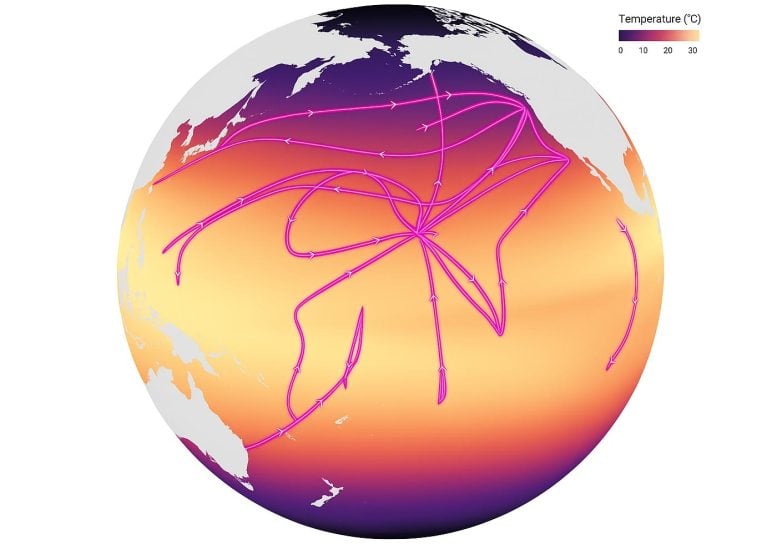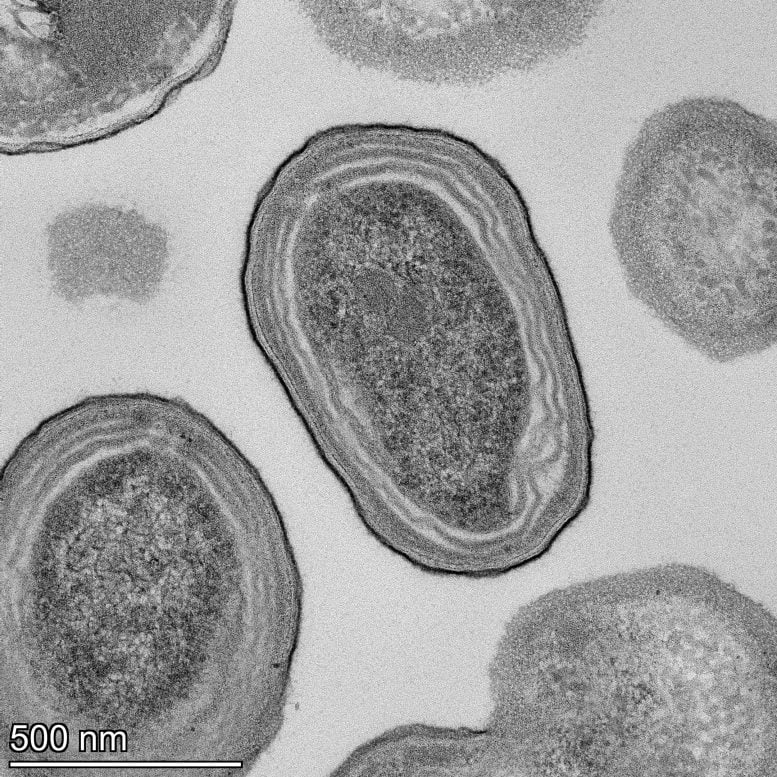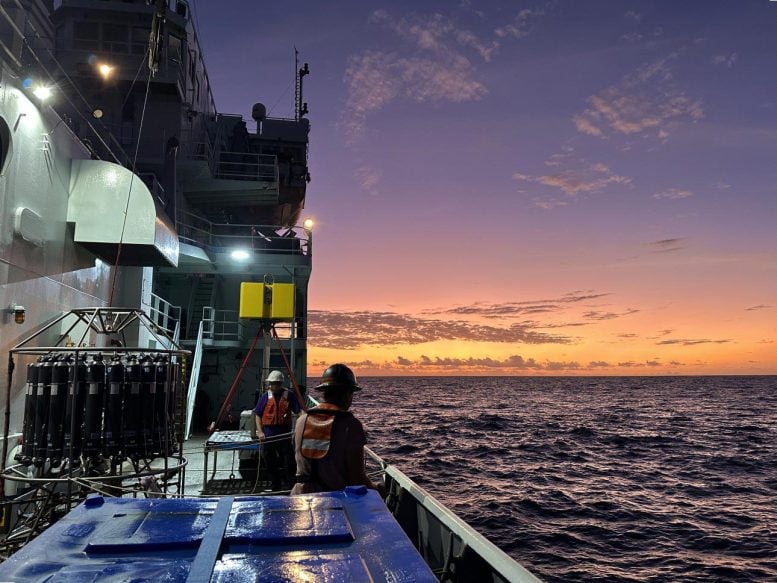
Tiny ocean microbes called Prochlorococcus, once thought to be climate survivors, may struggle as seas warm.
These cyanobacteria drive 5% of Earth’s photosynthesis and underpin much of the marine food web. A decade of research shows they thrive only within a narrow temperature range, and warming oceans could slash their populations by up to 50% in tropical waters.
Ocean’s Microscopic Powerhouses
Among the smallest organisms in the sea are microscopic, single-celled creatures known as Prochlorococcus. These microbes belong to the cyanobacteria group, also called blue-green algae, and they form the base of the food supply for animals throughout the marine food web. Today, more than 75% of the sunlit surface ocean is filled with Prochlorococcus, yet scientists warn that warming waters may soon become too hot for them to thrive.
Prochlorococcus holds the title as the most abundant photosynthesizing organism in the ocean and is responsible for about 5% of all photosynthesis on Earth. Because it naturally flourishes in tropical waters, researchers once assumed it would handle climate change with ease. However, new evidence shows that the microbe grows best at temperatures between 66 and 86 degrees and struggles to survive above that range. Climate projections suggest that within the next 75 years, many tropical and subtropical regions will surpass this limit.

Global Food Chain at Risk
“For a long time, scientists thought Prochlorococcus was going to do great in the future, but in the warmest regions, they aren’t doing that well, which means that there is going to be less carbon — less food — for the rest of the marine food web,” said François Ribalet, a University of Washington research associate professor of oceanography, who led the study.
Their results were published in Nature Microbiology on September 8.
Massive Field Studies at Sea
In the past 10 years, Ribalet and colleagues have embarked on close to 100 research cruises to study Prochlorococcus. His team has analyzed approximately 800 billion Prochlorococcus-sized cells across 150,000 miles around the world to figure out how they are doing and whether they can adapt.
“I had really basic questions,” Ribalet said. “Are they happy when it’s warm? Or are they not happy when it’s warm?” Most of the data comes from cells grown in culture, in a lab setting, but Ribalet wanted to observe them in their natural ocean environment. Using a continuous flow cytometer — called SeaFlow — they fired a laser through the water to measure cell type and size. They then built a statistical model to monitor cell growth in real time, without disturbing the microbes.

Temperature: The Decisive Factor
Results showed that the rate of cell division varies with latitude, possibly due to the amount of nutrients available, sunlight or temperature. The researchers ruled out nutrient levels and sunlight before zeroing in on temperature. Prochlorococcus multiply most efficiently in water that is between 66 and 84 degrees, but above 86, rates of cell division plummeted, falling to just one-third of the rate observed at 66 degrees. Cell abundance followed the same trend.
Living on Almost Nothing
In the ocean, mixing transports most nutrients to the surface from the deep. This occurs more slowly in warm water, and surface waters in the warmest regions of the ocean are nutrient-scarce. Cyanobacteria are one of the few microbes that have adapted to live in these conditions.
“Offshore in the tropics, the water is this bright beautiful blue because there’s very little in it, aside from Prochlorococcus,” Ribalet said. The microbes can survive in these areas because they require very little food, being so small. Their activity supports most of the marine food chain, from small aquatic herbivores to whales.

Evolutionary Trade-Offs
Over millions of years, Prochlorococcus has perfected the ability to do more with less, shedding genes it didn’t need and keeping only what was essential for life in nutrient-poor tropical waters. This strategy paid off spectacularly, but now, with oceans warming faster than ever before, Prochlorococcus is constrained by its genome. It can’t retrieve stress response genes discarded long ago.
“Their burnout temperature is much lower than we thought it was,” Ribalet said. The previous models assumed that the cells would continue dividing at a rate that they can’t sustain because they lack the cellular machinery to cope with heat stress.
Possible Competitor: Synechococcus
Prochlorococcus is one of two cyanobacteria that dominate tropical and subtropical waters. The other, Synechococcus, is larger, with a less streamlined genome. The researchers found that although Synechococcus can tolerate warmer water, it needs more nutrients to survive. Should Prochlorococcus numbers dwindle, Synechococcus could help fill the gap, but it isn’t clear what the impact of this would be on the food chain.
“If Synechococcus takes over, it’s not a given that other organisms will be able to interact with it the same way they have interacted with Prochlorococcus for millions of years,” Ribalet said.

Climate Models Predict Steep Decline
Climate projections estimate ocean temperatures based on greenhouse gas emission trends. In this study, the researchers tested how Prochlorococcus might fare in moderate- and high-warming scenarios. In the tropics, modest warming could reduce Prochlorococcus productivity by 17%, but more advanced warming would decimate it by 51%. Globally, the moderate scenario produced a 10% decline while warmer forecasts reduced Prochlorococcus by 37%.
“Their geographic range is going to expand toward the poles, to the north and south,” Ribalet said. “They are not going to disappear, but their habitat will shift.” That shift, he added, could have dramatic implications for subtropical and tropical ecosystems.
Unanswered Questions Remain
Still, the researchers acknowledge the limitations of their study. They couldn’t study every cell or sample every body of water. Their measurements are based on pooled samples, which could mask the presence of a heat-tolerant strain.
“This is the simplest explanation for the data that we have now,” Ribalet said. “If new evidence of heat-tolerant strains emerges, we’d welcome that discovery. It would offer hope for these critical organisms.”
Reference: “Future ocean warming may cause large reductions in Prochlorococcus biomass and productivity” by François Ribalet, Stephanie Dutkiewicz, Erwan Monier and E. Virginia Armbrust, 8 September 2025, Nature Microbiology.
DOI: 10.1038/s41564-025-02106-4
Co-authors include E. Virginia Armbrust, a UW professor of oceanography; Stephanie Dutkiewicz, a senior research scientist in the Center for Sustainability Science and Strategy at MIT; and Erwan Monier, co-director of the Climate Adaptation Research Center and an associate professor in the Department of Land, Air and Water Resources at UC Davis.
This research was funded by the Simons Foundation and other government, foundation, and industry funders of the MIT Center for Sustainability Science and Strategy.
Never miss a breakthrough: Join the SciTechDaily newsletter.
5 Comments
Right. So did the team also study Prochlorococcus during the last three geological warming periods, the Paleocene-Eocene Thermal Maximum (PETM), which occurred around 56 million years ago, when global temperatures rose significantly, likely by 9 to 14°F (5 to 8°C), the Cretaceous Hothouse around 100 million years ago and the Neoproterozoic period between 600 and 800 million years ago? Nope.
What’s your point or do you have one?
The point is, questioning the extinction concerns of the authors when various strains of the Prochlorococcus have apparently been around since the Great Oxygen Revolution, and have survived episodes of greater warming than anybody is predicting for the remaining time of this interglacial, the Holocene.
The unstated assumption of the authors is that this organism is immune from evolutionary pressures and will neither evolve adaptations that will allow survival or that there won’t be a shift in the propoeritons of the dominant strains that already exist. The authors have made a reasonable case for the existing dominant strains being ill-adapted to greater warming. However, what they have NOT done is make a case for the inability to evolve adaptations to a warmer environment.
I have a question for you: What is the point of your snark?
The strange word above is supposed to be “proportions.” I do wish we could edit or delete our comments.
So, it’s global warming again now, is it? The buzzword had given way to “climate change” for a while, when they realised the warning had stopped.
The fearmongers should really get it together before they come out fearmongering, because they look increasingly silly.
And someone tell me: how is it possible that the life on earth was thriving eons ago, in a much warmer atmosphere – yet now it’s supposed to be in danger because of some 0.5 degrees increase?